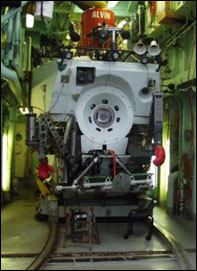
Alvin
With information from both DSL-120 and Argo, scientists will pick their dive targets for Alvin, a 23 foot high, 12 foot tall research submarine that can carry a pilot and two researchers at a time to depths as great as 4,500 meters (14,764 feet) for as long as eight hours.
Fig. 1. Alvin in the hangar aboard the R/V Atlantis. Photo by Monte Basgall.
With its small 3½ inch thick plastic portholes, and two robot manipulator arms Alvin uses to grasp and remove rock samples, the tiny sub resembles a marine crustacean. But it is an engineering marvel that uses thrusters and a rudder to operate on its own, ambling at up to six knots, or rising, hovering and settling to the bottom.
To endure pressures great enough to compress a plastic drinking cup to almost thimble size (a favorite demonstration), Alvin's hull is made of titanium almost 2 inches thick. After wriggling through the 20 inch diameter hatch in its conning tower, researchers spend the day shoehorned in the sub's chilly, cramped cockpit surrounding by glowing instruments.
Link: Alvin
For more information on the Alvin, check out the Woods Hole Oceanographic Institution page: http://www.whoi.edu/home/marine/alvin_main.html
During hours that always seem too short, they tape record impressions of what they see through the portholes, use a joystick to manipulate external video cameras, take digital still pictures from the cockpit, ask the pilot to collect rocks for later analysis, fill out data logs in the dim light, and in between take a spartan lunch break of sandwiches and black coffee.
 Alvin has 10 lights to penetrate the gloom and a total of six external cameras. It also has elaborate rules. Nail polish, lip balm, makeup or colognes are forbidden out of concern for fire and working in close confines. There are pain relievers available for headaches brought on by higher than normal carbon dioxide levels.
Alvin has 10 lights to penetrate the gloom and a total of six external cameras. It also has elaborate rules. Nail polish, lip balm, makeup or colognes are forbidden out of concern for fire and working in close confines. There are pain relievers available for headaches brought on by higher than normal carbon dioxide levels.
Fig. 2. Researcher Steve Hurst being fitted for the Alvin emergency oxygen mask by Alvin pilot Bruce Strictrott. Photo by Monte Basgall.
During the past few days all on the research team have been undergoing pre-dive orientations where they learned the dos and don'ts, the contingency plans to deal with loss of power or air supply, and the multiple ways to return to the surface in emergencies. During the initial fire and abandon ship drill, all potential divers were also fitted for oxygen masks.
To learn more about the vehicles:
DSL-120 | Argo II | Alvin

|








